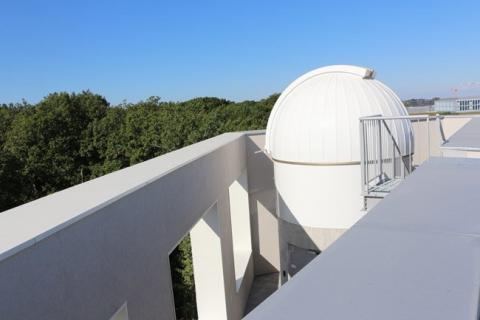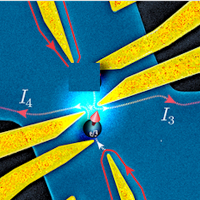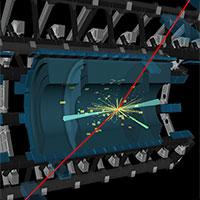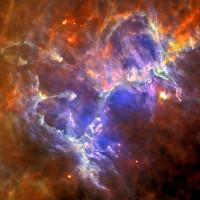
Research at the Physics Graduate School
Research is conducted by more than 3,000 researchers, engineers and technicians in some forty laboratories on the Université Paris-Saclay campus. They bring together a very wide range of scientific and technical expertise and professions. They are carried out within multiple collaborations, in Ile-de-France, nationally, Europe or worldwide, and give rise to numerous synergies with the local and national industrial sector. One of the specificities of Paris-Saclay Physics is also the number and diversity of platforms and large research instruments at the cutting edge of what is being done in the world and which have a very high national and international profile. Locally, this research contributes to the training of a thousand master's students and doctoral candidates.
Research in Physics at Université Paris-Saclay is organized into three thematic areas: Physics of Waves and Matter (PhOM), Physics of the 2 Infinites (P2I), and Astrophysics.
The European StarPhy COFUND project has been accepted
This funding will enable the launch of the UPSaclay STAR φ program, which will offer the opportunity to recruit up to 41 international postdoctoral researchers through two calls for applications. The selected researchers will carry out 24-month research projects across a wide range of fields in physics.
Applicants will be invited to propose a research project aligned with the activities of the 40 research laboratories of the Graduate School of Physics, as well as those of the SOLEIL synchrotron and the National Laboratory of Metrology and Testing (LNE).
This funding represents a major step forward in promoting international collaboration, scientific excellence, and the training of a new generation of physics researchers.
Click the link to learn more: https://www.cofund-physics.universite-paris-saclay.fr/

Physics of Waves & Matter (PhOM)
This involves the study, description, and application of the principles and phenomena of physics at scales ranging from the atom to the planet, as well as the emergence of complexity in systems with (very) many components, governed by multiple interactions in cooperation or competition. It includes the fields of extreme light, the physics of neutral or ionised dilute media (including atomic physics, molecular physics, and plasma physics), nanophysics, growth and properties of materials, the physics of quantum coherence and correlations (including quantum materials and topology effects), quantum entanglement and technologies, optics and photonics, complex systems and matter. PhOM teams lead research programmes in fundamental and applied physics, experimental as well as theoretical, within their disciplinary field as well as in the broad interdisciplinary context.

Physique of the 2 Infinities (P2I)
Major questions concern the ultimate and infinitely small components of matter and the fundamental laws governing their interactions, the origin and evolution of the infinitely large components of the Universe, the strong interaction, the emergence of complexity, and the origin of elements in the Universe. Specific fields include particle physics, nuclear physics, astroparticle physics, cosmology, theoretical physics, energy (including nuclear reactor physics) and health. P2I teams are members of the very large, internationally recognised research infrastructures. They possess a unique know-how in cutting-edge technologies and also conduct original interdisciplinary research on societal issues (in particular health and energy).

Astrophysics
The major questions concern the functioning of the solar system, the formation and evolution of stars and planetary systems, the formation and evolution of large structures, and physics under extreme conditions. The fields covered are cosmology, galaxies, high energies, the interstellar medium, extraterrestrial matter, star formation, planetary sciences, solar and stellar physics, and astrophysical plasmas. The main methods used are ground and space instrumentation (in the broadest sense, including all phases from the design of observation instruments to their astrophysical exploitation), data and signal science, data analysis and interpretation, numerical simulations and theoretical work.

The laboratories
- Centre de Nanosciences et de Nanotechnologies (C2N)
- Département Optique et Techniques Associées (DOTA)
- Département Physique Instrumentation Environnement Espace (DPHY)
- Fluides, Automatique et Systèmes Thermiques (FAST)
- Laboratoire de Génie Electrique et Electronique de Paris (GeePs)
- Groupe d'Etude de la Matière Condensée (GEMaC)
- Institut de Chimie Moléculaire et des Matériaux d'Orsay (ICMMO)
- Institut de Chimie Physique (ICP)
- IJCLab/Pôle Astroparticules, Astrophysique et Cosmologie
- IJCLab/Pôle Energie et Environnement
- IJCLab/Pôle Ingénierie
-
Institut photonique d'analyse non-destructive européen des matériaux anciens (IPANEMA)
- Institut de physique théorique - DRF (IPhT)
- Département des Accélérateurs, de la Cryogénie et du Magnétisme (IRFU/DACM)
- Département d'Astrophysique (IRFU/DAp)
-
Département d'Electronique des Détecteurs et d'Informatique pour la Physique (IRFU/DEDIP)
- Département de Physique Nucléaire (IRFU/DPhN)
- Département de Physique des Particules (IRFU/DPhP)
- Institut des Sciences Moléculaires d'Orsay (ISMO)
- Laboratoire Aimé Cotton (LAC)
-
Laboratoire Atmosphères, Milieux, Observations Spatiales (LATMOS)
- Laboratoire Charles Fabry (LCF)
- Laboratoire d'étude des microstructures (LEM)
- Laboratoire Interactions, Dynamiques et Lasers (LIDYL)
- Laboratoire Léon Brillouin - DRF/IRAMIS (LLB)
- Laboratoire Matière sous conditions extrêmes - DAM (LMCE)
- Laboratoire de Physique des Gaz et des Plasmas (LPGP)
- Laboratoire de Physique de Plasmas (LPP)
- Laboratoire de Physique des Solides (LPS)
- Laboratoire de physique théorique et modèles statistiques (LPTMS)
- Lumière, Matière et Interfaces (LuMIn)
- Nanosciences et Innovation pour les Matériaux, la Biomédecine et l'Energie (NIMBE)
- Photophysique et Photochimie Supramoléculaires et Macromoléculaires (PPSM)
-
Service d'étude des réacteurs et de mathématiques appliquées - DES/ISAS/DM2S (SERMA)
- Synchrotron SOLEIL (SOLEIL)
- Service de Physique de l'état condensé (SPEC)
- Structures, propriétés et modélisation des solides (SPMS)
- Service de Recherches Métallurgiques Appliquées - DEN/DMN (SRMA)
- Service de Recherches de Métallurgie Physique - DES/ISAS/DMN (SRMP)
- Unité mixte de physique CNRS/Thales (UMPhy)
